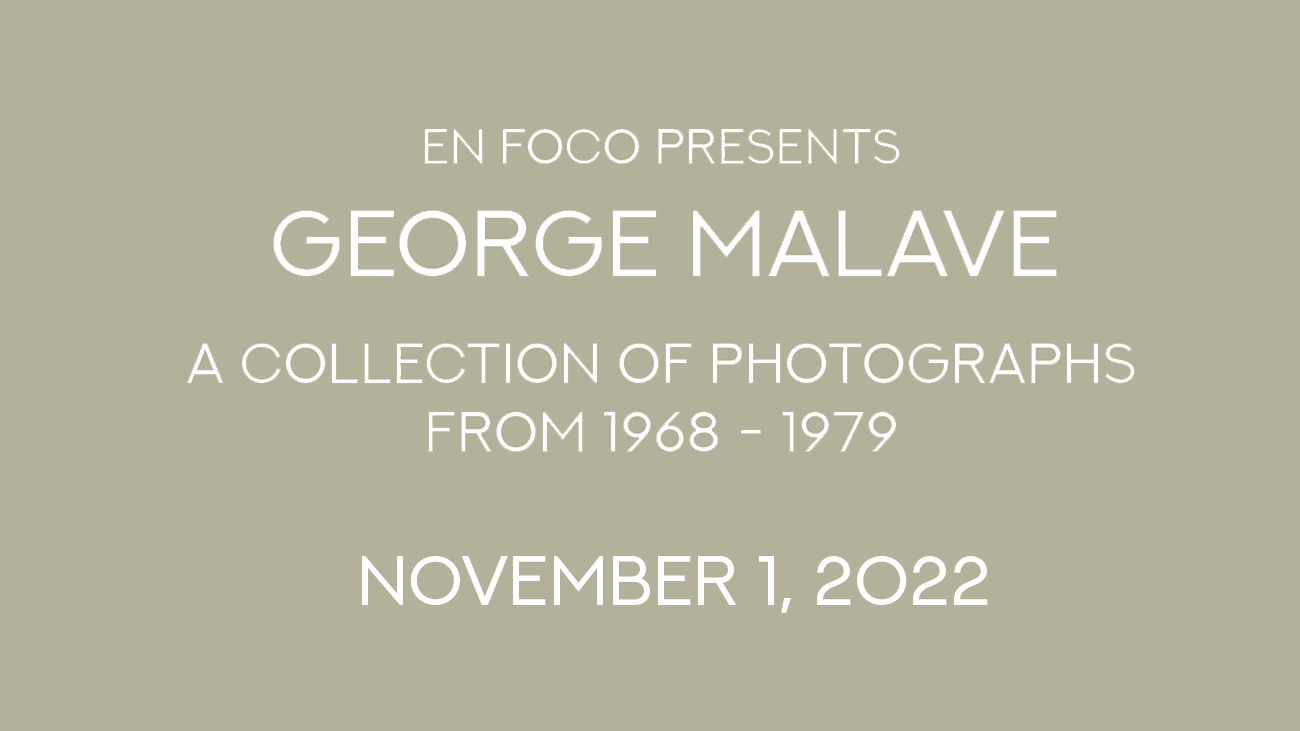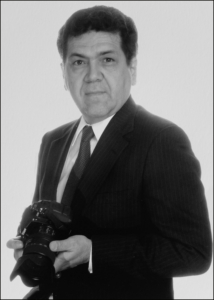
George Malave: A Collection of Photographs from 1968 – 1979, features a selection of works from prolific photographer, and original En Foco Member, George Malave including: Varet Street Kids, Third Avenue El, and other historic images of the Bronx.
Exhibition on View:
November 1, 2022 – January 1, 2023
on the En Foco website.
The Tao of George Malave
By Bill Aguado
Published in Nueva Luz Vol. 26.1
George Malave is a product of a generation of Puerto Rican photographers working in the late 1960s and early 1970s that became an informal collective of voices, representing the many faces of the community and documenting the injustices it was forced to endure.These photographers had unique perspectives of their communities, recognizing that no two were alike, yet representing the spirit of the moment through the intimacy of their lens. They shared their thoughts, insights, and challenges with each other as they matured individually as artists. George gives credit to this collective learning exchange as part of his development as a photographer. But he also emphasizes the experience of the 1973 exhibition, Dos Mundos: Words of the Puerto Rican. Curated by fellow photographer Geno Rodriguez, the exhibition brought together twelve Puerto Rican artists—six from New York City and six from Puerto Rico—to showcase the quality and artistry of this cohort that were unknown to the broader mainstream and certainly unfunded.
As an original member of En Foco, George acknowledges its formation by several of the Dos Mundos artists as a way to sustain the spirit of the collective while addressing developmental issues for its artists. He also attributes the impact of Charles Biasiny-Rivera’s leadership role as essential to enabling En Foco to serve generations of artists from the 1970s to today. The collective spirit of the artists in the Dos Mundos exhibition and En Foco launched many careers. Nonetheless, the impact of this collective and its history remains generally unknown. Sadly many of the artists are under-recognized except by a few art historians, artists, friends, and colleagues, who were also part of this generation.
This is a long introduction to George Malave whom I consider an artist of rare distinction. The quality of his work from the 1970s onward reflects the dignity and clarity of the subject on the other side of his lens and continues to this day. His images do not exploit neighborhoods as symbols of urban rot like so many have to further their careers as photojournalists. Rather, his photographs retain the same relevance they did five decades ago when he began his career. George was born in Puerto Rico and raised in Brooklyn. He studied art in his early years before moving to photography as his primary form of expression. However, he is also a painter and has a substantial portfolio of work. I refer to his early years as a painter as an important influence that helped him develop as a photographer, specifically a clear understanding of composition and perspective. In this way, he is a photographer who paints with his lens, capturing a familiarity and moment in time.
George has been an artist and photographer for over fifty years and his work has been featured in numerous exhibitions. His images have been published in media outlets and as books. However, particularly significant to the turmoil and life of the early 1970s are the Third Avenue El series (1972–73), Varet Street Kids series (1968–69), and a pictorial spread that appeared in SoHo News Weekly in 1975. These three collections of images capture an era of social upheaval, urban change, and a bankrupt New York City. Despite this, the photographs also contain a sense of humanity in contrast to their time. It is this sensitivity that elevates George’s images beyond their context without being exploitive. Varet Street Kids, exhibited and published in the late 1960s, is a testimonial to the adaptive nature of urban youth living in the midst of tenements, abandoned buildings, and acres of vacant, garbage-strewn lots. Varet Street in Brooklyn represented what New York City came to be known as: a national symbol of urban Devastation.
However, within the Varet Street neighborhood, in the absence of leisure time amenities, the youth not only survived but also thrived, substituting such middle-class fixtures as swimming pools with fire hydrants blasting water on hot summer afternoons. This included street games, as evidenced by Johnny on the Pony (1968–69), where a youth team competes by jumping on the backs of another team, bracing themselves against the wall and rotating turns. A daily routine of young girls jumping rope, hanging out in the abandoned lots, and other improvised activities, defined urban living. The Varet Street games seen in these photographs were no different than any other street, neighborhood, or City borough from the 1950s through the 1970s. It was a time of resilience and building community among youth groups even while oblivious to their social and economic circumstances. The smiles on their faces, the mugging for the camera, and the friendship depicted in the photographs captured a sensitive portrayal of growing up in any neighborhood in New York City.
The Third Avenue El in the Bronx was a remnant of an age where the elevated subway was omnipresent throughout the City until giving way to more efficient surface transportation, allowing pedestrians, buildings, and communities formerly shrouded in shadows to experience the sun. George’s photographs of the Bronx El a couple of years before it was demolished documented the end of an era. The images, ghost-like in nature, also represented a time of change in the Bronx as it experienced a massive demographic shift with white flight. Taken from a variety of perspectives, the photographs captured a sense of isolation and structural trauma that spilled into the community and its ridership. The most iconic representation was that of train tracks suffocating a courthouse, so close to the facade it was seemingly within arm’s length. The sense of abandonment and isolation of the many communities the El connected is evident in the eerie images of the streets under it, foreshadowing a Bronx that continues to be remembered for its abandonment, crime, and arson. Together, the photographs of the Third Avenue El document a Bronx that has been forgotten by time.
The 1975 Street Life exhibition at SoHo’s Foto Gallery documents an underclass that was abandoned. The faces of the people photographed represented the impact of a triage-like social services policy with an empty cupboard. The sensitive and provocative portrayals of the neediest, the homeless, the infirm, and the elderly in these photographs presented an understanding of the human condition without romanticizing it. The Street Life photographs captured the faces of social disintegration and hopelessness of a City equally in despair, hinting at a dystopian reality that did not bode well for future generations.
There is a raw quality to the images that relay a sad narrative without being exploitive. The images capture scenes reminiscent of the 1930s Depression era, a period when photography became an invaluable new tool for social justice, positioning photographers as spokespersons for the people. In this body of work, George successfully pays homage to that tradition.
George’s photography over the years has remained consistent in its narratives. He celebrates the traditions and dignity of the subjects he communicates with through his lens. Even when he is documenting the most challenging of circumstances, his work evokes sensitivity without falling victim to sensationalism. I urge everyone to explore George Malave’s photography from his early days as a member of a socially conscious collective of Puerto Rican photographers to the present. He is an extraordinary, under-recognized artist in the public realm who is deeply appreciated by his peers and colleagues.

Born in 1946 in Puerto Rico, George Malave arrived in New York as an infant where he was raised and educated. His interest in art began at an early age and he discovered photography in his twenties, studying at the Educational Alliance under Dr. Al Freed at the Germain School of Photography in Manhattan. He earned a BA in photography from the State University of New York and has taught and lectured on
photography at various educational institutions. He was awarded a Creative Artist Public Service Fellowship in 1974 to study New York street life and National Endowment for the Arts Survey Grant in 1984 to photograph New York’s Financial District. His photographic body of work includes the series: Varet Street Kids (1968–69), Third Avenue El (1972–73), CCF/CETA Artists Project (1978–79), World Trade Center: Before, During & After 9/11 (1984–2021), Motherhood (1975–2022), Aging (1967–2020), The Tourist (1970–2021), Human in Nature (1995–2020), Crowdscapes (1980–90), and several experimental projects.
Malave’s works have been exhibited at the International Center of Photography, New York, New York, New York State Museum, Albany, New York, Museum of the City of New York, New York, New York, Oklahoma City Museum of Art, Oklahoma City, Oklahoma, Danforth Art Museum, Framington, Massachusetts, Snite Museum of Art, Notre Dame, Indiana, El Paso Museum of Art, El Paso, Texas, Bronx Museum of the Arts, Bronx, New York, Camera Work Gallery, Port Washington, New York, New-York Historical Society, New York, New York, Wave Hill, Bronx, New York, Neikrug Gallery, New York, New York, Corcoran Gallery of Art, Washington, D.C., BRIC House, Brooklyn, New York, and CityLore Gallery, New York, New York. His works are held in the permanent collections of the New York Public Library and New York City Municipal Archives as well as in private collections. His publications include: Third Avenue El / Bronx, N.Y. 1972–73 (2004), The Tourist/Photographic Wanderings (2006) with an introduction by Judd Tully, CREATURES (2008) with an introduction by A. D. Coleman, and Varet Street Kids 1968–69 (2018) with an essay by Elizabeth Ferrer.

Nueva Luz Vol 26.1 featured the 2022 En Foco Photography Fellowship, and Works-In-Progress awardees, and included The Tao of George Malave, written by En Foco’s Executive Director, Bill Aguado. The issue is available for free in PDF Format in the Nueva Luz Digital Archive, and available for purchase now.
About Nueva Luz
Designed to support photographers of color who demonstrate the highest quality of work as determined by a photography panel of peers and industry professionals, the Fellowship initiative affirms En Foco’s ongoing commitment to the financial support of artists of color and serves to inform exhibition organizers and curators of an existing pool of quality under-recognized artists.
Launched in 1985, Nueva Luz is an ongoing art publication that addresses social and cultural issues at the fore of photography, with a particular emphasis on narratives from artists of color. From its inception, the publication’s mission was to advance the professional status of contemporary photographers of diverse backgrounds and cultures.
This exhibition is supported in part by public funds from the New York City Department of Cultural Affairs, in partnership with the City Council, New York State Council on the Arts with the support of Governor Kathy Hochul and the New York State Legislature, Ford Foundation, The Lily Auchincloss Foundation, Joy of Giving Something, Inc., and private contributions. Member of the Urban Arts Cooperative.